Manual coffee grinders offer a traditional brewing experience, connecting users with coffee’s rich past while providing cost-effective, eco-friendly, and timeless charm for coffee enthusiasts.
1.1 The Appeal of Manual Coffee Grinders
Manual coffee grinders charm coffee enthusiasts with their timeless design, cost-effectiveness, and compact size. They offer a sensory experience, ideal for coffee purists seeking control over their brew. Vintage models, often more affordable, provide a nostalgic connection to coffee’s heritage, making them a popular choice for both beginners and collectors. Their durability and ease of use further enhance their appeal, as they eliminate the need for electricity, perfect for home or outdoor use.
1.2 Why Vintage Manual Grinders Are Popular
Vintage manual grinders captivate collectors and coffee lovers with their historic charm and affordability. These grinders, often less than a century old, provide a nostalgic brewing experience while maintaining functionality. Their compact design and durability make them ideal for both home use and travel. Additionally, vintage grinders are eco-friendly, requiring no electricity, and offer a cost-effective alternative to modern electric grinders, appealing to those who value simplicity and tradition in their coffee preparation.
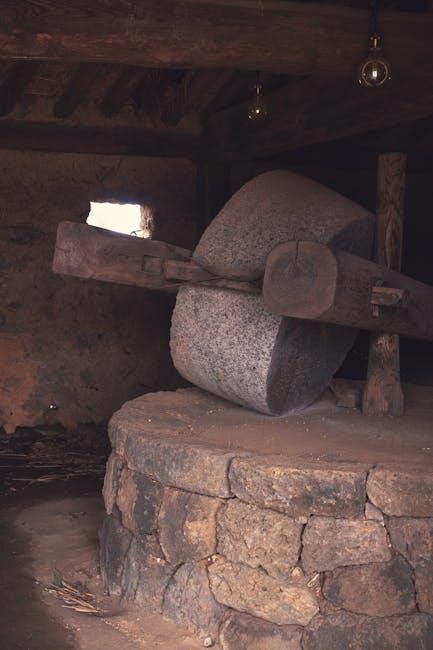
Types of Manual Coffee Grinders
Manual coffee grinders come in burr and blade types, offering durability and classic designs. Popular vintage models are sought for their timeless functionality and nostalgic appeal.
2.1 Burr vs. Blade Grinders: What’s the Difference?
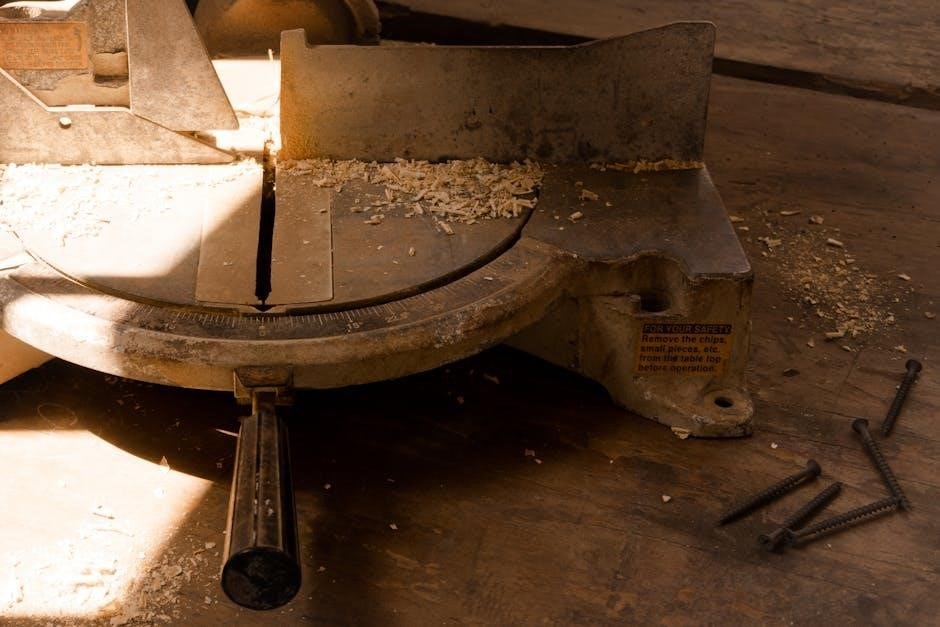
Burr grinders use abrasive surfaces for consistent grinding, ideal for coffee brewing methods. Blade grinders chop beans unevenly, potentially burning them. Burr grinders, often found in vintage models, offer superior consistency and flavor, making them preferable for coffee enthusiasts seeking quality and durability in their grinding experience.
2.2 Popular Brands and Models of Vintage Grinders
Popular vintage grinder brands include Zassenhaus, Peugeot, and Arcoroc, known for durability and timeless design. Models like the Union grinder and Enterprise No. 1 are sought after for their consistent grind quality. The Spong grinder is another vintage favorite, offering reliability and ease of use. These grinders are often found in antique shops or flea markets, appealing to collectors and coffee enthusiasts who value craftsmanship and historical significance in their brewing tools.
2.3 Ceramic vs. Steel Burrs: Which Is Better?
Ceramic burrs are prized for their hardness, reducing heat transfer and preserving coffee’s natural oils, while steel burrs offer durability and ease of cleaning. Ceramic burrs are quieter and ideal for lighter roasts, whereas steel burrs handle darker roasts better. Both options provide consistent grinds, but ceramic burrs are more fragile and require careful handling. The choice often depends on personal preference, budget, and the type of coffee beans being used, balancing performance and maintenance needs effectively.
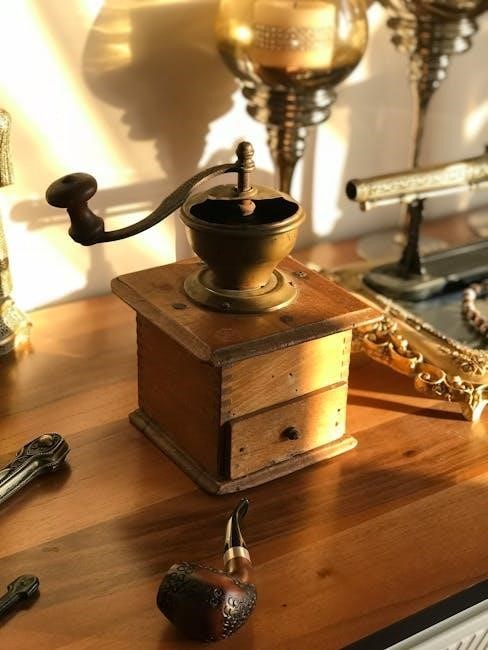
Benefits of Using a Manual Coffee Grinder
Manual grinders enhance flavor by ensuring freshly ground beans, offer cost savings, and are environmentally friendly, making them a sustainable and space-efficient choice for coffee lovers.
3.1 Control Over Grind Size and Consistency
Manual grinders provide precise control over grind size, essential for various brewing methods. Adjustments ensure consistency, from fine espresso grinds to coarse French press textures, enhancing flavor extraction.
3.2 Cost-Effectiveness and Durability
Manual coffee grinders are affordable and durable, offering long-term savings. Vintage models, often made from robust materials, withstand years of use, reducing the need for frequent replacements and providing a sustainable choice for coffee enthusiasts.
3.3 Environmental and Space-Saving Advantages
Manual coffee grinders are eco-friendly, eliminating electricity use and reducing energy consumption. Vintage models are compact, saving kitchen space and offering portability for travel. Their durable design minimizes waste, aligning with sustainable living. These grinders promote a greener coffee routine while fitting seamlessly into modern, space-conscious lifestyles.
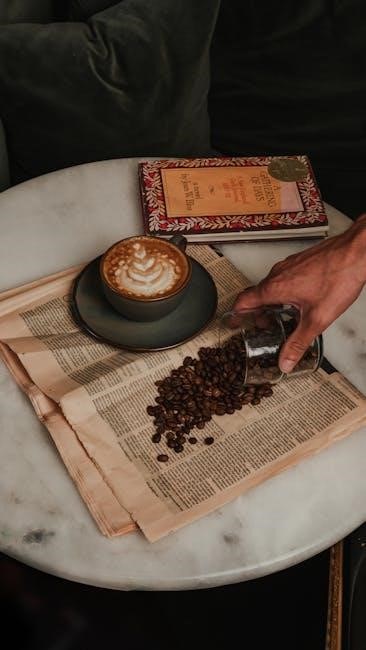
How to Choose the Right Manual Grinder
Selecting the right manual grinder involves considering your brewing habits, budget, and desired grind consistency. Align your choice with your coffee preferences for optimal results.
4.1 Understanding Your Brewing Method
Your brewing method determines the ideal grind size. For espresso, a fine grind is essential, while pour-over and French press require coarser textures. Manual grinders offer adjustable settings to cater to these needs, ensuring precision for your preferred brewing technique. By aligning your grinder with your brewing habits, you can achieve consistent results and elevate your coffee experience. This step is crucial for making the most of your manual grinder’s capabilities.
4.2 Features to Look for in a Vintage Grinder
When selecting a vintage grinder, look for sturdy materials like wood or metal, ensuring durability. Check for adjustable grind settings to suit various brewing methods. Inspect the burrs for sharpness and alignment, as they directly impact grind consistency. Aesthetic appeal and historical charm are bonuses, but functionality should remain a priority. Ensure the grinder is clean and well-maintained, with minimal wear on moving parts. Proper lubrication and smooth operation are essential for optimal performance.
4.3 Budget Considerations
Manual coffee grinders are generally affordable, with prices starting around $10-$20. Vintage grinders can be even more budget-friendly, often costing less than modern alternatives. When purchasing, balance cost with quality, ensuring durable materials and functional mechanics. Consider the grinder’s longevity and maintenance needs to maximize value. Negotiating prices for vintage finds can also help stay within budget while acquiring a charming, functional piece for your coffee routine.
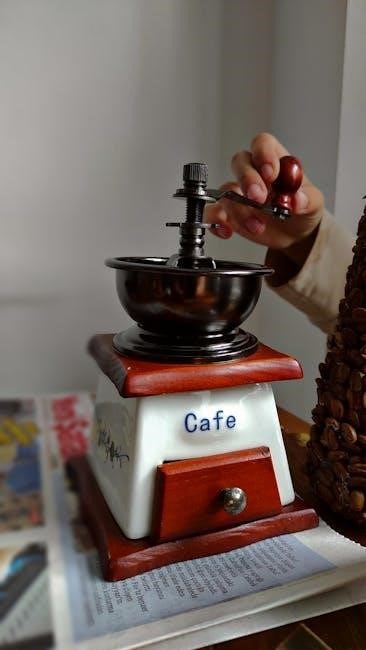
Maintenance and Care for Vintage Grinders
Regular cleaning, gentle lubrication, and careful restoration preserve the functionality and charm of vintage grinders, ensuring they remain reliable and visually appealing for years to come.
5.1 Cleaning and Lubricating Your Grinder
Regular cleaning and lubrication are essential to maintain the performance and longevity of vintage grinders. Use a soft cloth to wipe down surfaces and remove coffee residue. For internal parts, a small brush can help clear grounds. Lubricate moving components with food-safe oils to ensure smooth operation. Avoid harsh chemicals, as they may damage materials. Proper care preserves functionality and retains the grinder’s nostalgic appeal, making it a reliable tool for coffee preparation.
Additionally, grinding a small amount of rice can absorb odors and residue inside the grinder. Always dry thoroughly after cleaning to prevent rust or corrosion. This meticulous maintenance ensures vintage grinders continue to serve as trusted companions in the coffee-making process.
5.2 Restoring Antique Coffee Grinders
Restoring vintage grinders involves careful disassembly, polishing, and refinishing to revive their original charm. Gently clean corrosion using mild vinegar or baking soda. Replace worn parts like burrs or handles with compatible replacements. For wooden components, a light sanding and oil finish can restore their luster. Avoid over-restoration to preserve historical authenticity. Patience and attention to detail ensure these timeless pieces regain functionality while retaining their nostalgic appeal and character.
Refurbishing not only extends the grinder’s life but also honors its heritage, making it a functional and cherished addition to any coffee setup. This process requires dedication and a passion for preserving the past, ensuring each grinder remains a testament to craftsmanship and tradition.
5.3 Troubleshooting Common Issues
Common issues with vintage grinders include inconsistent grinds, difficulty turning the handle, or worn-out burrs. Check for clogs and clean thoroughly with a brush or mild soap. Lubricate moving parts periodically to ensure smooth operation. If grind size varies, adjust the burrs or replace them if damaged. Addressing these problems promptly extends the grinder’s lifespan and maintains its performance, ensuring a consistent and enjoyable brewing experience for years to come.
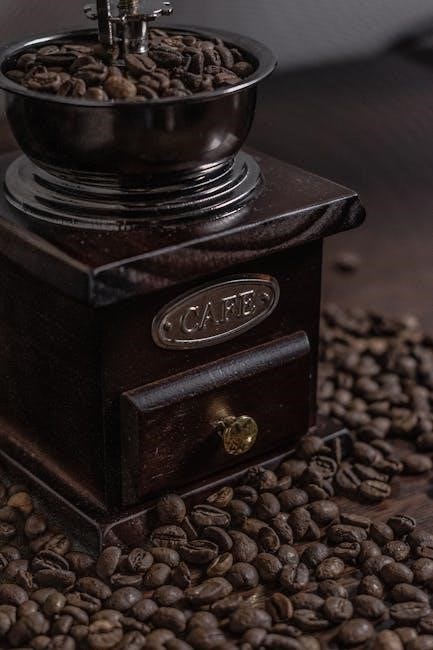
The History of Manual Coffee Grinders
Manual coffee grinders trace their roots to early coffee culture, evolving from simple mortars to intricate mechanisms over centuries, reflecting craftsmanship and enduring appeal in coffee preparation.
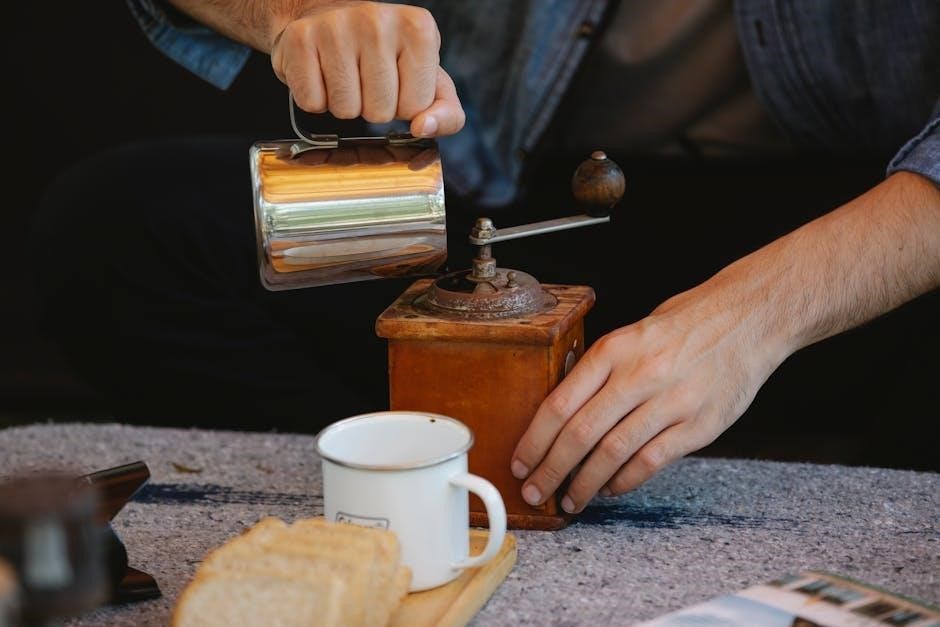
6.1 Evolution of Coffee Grinding Technology
Coffee grinding technology has evolved significantly, from ancient mortars to hand-cranked grinders. Early models used simple mechanisms, while modern designs incorporate advanced materials like ceramic and steel burrs. Vintage grinders, with their durable construction and timeless aesthetics, have maintained their appeal, blending traditional methods with functional efficiency. This progression reflects humanity’s quest for better flavor and convenience, preserving the essence of manual grinding.
6.2 Historical Significance of Vintage Grinders
Vintage manual coffee grinders hold a special place in history, reflecting the craftsmanship and simplicity of earlier eras. Many were crafted with precision, featuring durable materials like cast iron and hardwood. These grinders not only served as tools but also as decorative pieces, often passed down through generations. Their enduring appeal lies in their ability to connect users with the past, offering a tactile, authentic coffee experience that modern designs often can’t replicate.
6.3 How Vintage Grinders Compare to Modern Designs
Vintage grinders often feature simpler, manually operated mechanisms, emphasizing craftsmanship over efficiency. Modern designs, while more convenient, lack the charm of vintage aesthetics. Vintage grinders typically use ceramic or steel burrs, similar to modern ones, but their slower grinding process preserves coffee’s natural oils. Modern grinders prioritize speed and precision, making them ideal for consistent brews. Vintage grinders, however, offer a tactile, nostalgic experience, appealing to those who value tradition and the art of coffee preparation.
Using Your Manual Grinder for Different Brews
Manual grinders are a versatile tool for coffee enthusiasts, allowing customizable grind sizes for various brewing techniques. Learn to adjust settings easily to suit your preferred method, enhancing your coffee experience with each brew.
7.1 Grinding for Espresso vs. Pour-Over
Manual grinders excel at producing precise grind sizes for espresso and pour-over. Espresso requires a fine, even grind, while pour-over needs a coarser texture. Adjusting the burrs ensures optimal extraction for each method, enhancing flavor and aroma. Consistency is key to achieving the perfect brew, making manual grinders a versatile tool for coffee enthusiasts exploring various brewing techniques and savoring the unique qualities of their favorite beans.
7.2 Adjusting Grind Size for Various Brewing Methods
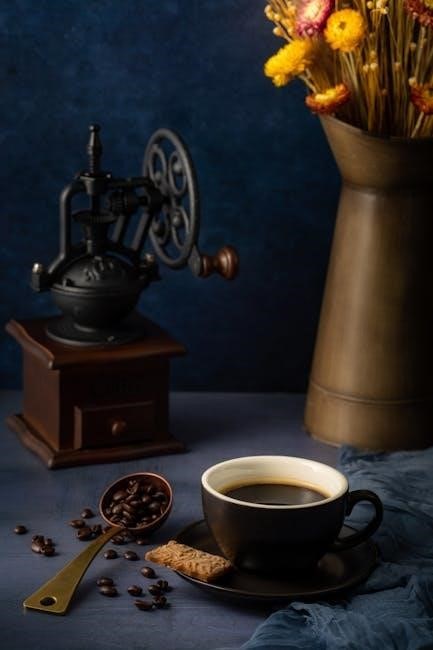
Manual grinders allow precise control over grind size, crucial for different brewing techniques. Fine grinds suit espresso for rich extraction, while coarser grinds are ideal for pour-over, French press, or Aeropress. Adjusting the burrs ensures optimal particle size, preventing under- or over-extraction. Consistent grind size enhances flavor and aroma, making manual grinders versatile for exploring diverse coffee methods and achieving the perfect balance in every cup.
7.3 Tips for Achieving the Perfect Grind
Achieving the perfect grind with a manual grinder requires attention to detail. Ensure burrs are clean and well-maintained for consistent results. Experiment with grind settings to match your brewing method, from fine for espresso to coarse for French press. Store beans properly to preserve freshness, and grind just before brewing for optimal flavor. Regularly cleaning and lubricating the grinder will maintain performance and extend its lifespan, ensuring every grind is precise and flavorful.
Buying Guide for Vintage Coffee Grinders
When purchasing vintage grinders, inspect condition, functionality, and authenticity. Research historical models, negotiate prices, and ensure all parts are intact for optimal performance and value.
8.1 Where to Find Vintage Grinders
Vintage manual coffee grinders can be discovered at antique shops, flea markets, and online marketplaces like eBay or Etsy. Estate sales and vintage kitchenware stores are also great sources. Additionally, specialty coffee shops or collectors may sell restored models. When shopping online, ensure sellers provide detailed photos and descriptions to verify authenticity and condition before purchasing.
8.2 What to Look for When Purchasing Antique Grinders
When buying vintage grinders, inspect for damage, rust, or worn burrs. Ensure all parts are intact and functional, with smooth grinding mechanisms. Look for high-quality materials like cast iron or hardwood. Research the grinder’s era and historical significance to assess value. Check for any restoration work and verify authenticity through markings or patents. A well-maintained grinder with original components will provide better performance and longevity.
8.3 Negotiating Prices and Ensuring Quality
When purchasing vintage grinders, negotiate prices based on condition and rarity. Compare similar listings to determine fair value. Ask sellers about restoration costs or needed repairs. Ensure the grinder’s authenticity by checking for original parts and markings. Request a demonstration to verify functionality. Consider budget-friendly options, as vintage grinders can be cost-effective. Prioritize grinders with minimal wear and functional mechanisms to ensure long-term use and satisfaction.
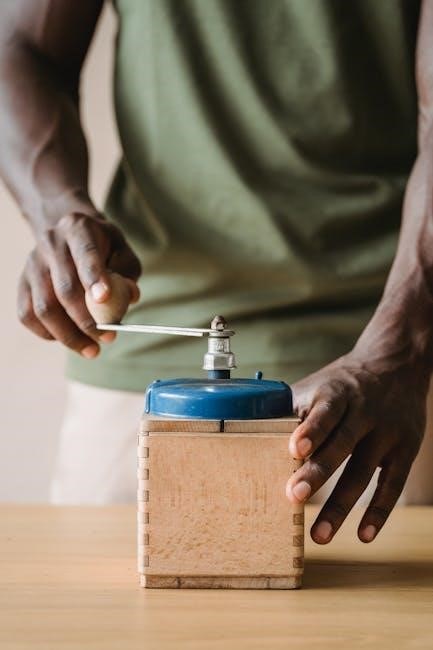
User Reviews and Recommendations
Users and experts praise manual coffee grinders for their durability and grind consistency. Many recommend vintage models for their timeless design and cost-effectiveness, enhancing home brewing experiences.
9.1 Top-Rated Manual Grinders According to Experts
Experts highly recommend grinders like the Zassenhaus, Peugeot, and Porlex for their exceptional grind consistency and durability. These vintage-inspired models are praised for their precise burrs and timeless designs, making them top choices among coffee enthusiasts. Many baristas and coffee aficionados swear by these grinders for their ability to produce uniform grounds, essential for professional-level brewing at home.
9.2 Common Feedback from Long-Term Users
Long-term users praise manual coffee grinders for their durability and consistent performance. Many highlight the satisfaction of the grinding process and the superior flavor it brings. Some note that vintage models require careful maintenance but offer a unique charm. Users often mention the cost-effectiveness and environmental benefits of manual grinders. However, a few point out that grind size consistency can vary, especially in older models, and durability may decrease with heavy use over time.
9.3 Recommendations for Beginners
For beginners, starting with a basic, affordable manual grinder is ideal. Look for models with simple designs and fewer grind settings to ease into the process. Vintage grinders can be a great budget-friendly option but ensure they are in good working condition. Practice adjusting the grind size gradually and pair it with your brewing method. Regular cleaning and maintenance will extend the grinder’s lifespan and ensure consistent results. Patience and practice will enhance your coffee experience.
Manual coffee grinders, especially vintage models, offer a timeless, cost-effective way to enjoy freshly ground coffee with a charming, hands-on brewing experience.
10.1 Final Thoughts on Manual Coffee Grinders
Manual coffee grinders, particularly vintage models, embody timeless charm and functionality. They offer precision, cost-effectiveness, and a unique tactile experience. For coffee enthusiasts, these grinders provide a hands-on brewing process that connects them to coffee’s heritage. Vintage grinders, with their historical appeal, add a touch of nostalgia to modern kitchens. Whether for daily use or occasional brewing, manual grinders remain a satisfying and enduring choice, blending tradition with the love of great coffee.
10.2 The Timeless Charm of Vintage Grinders
Vintage manual coffee grinders captivate with their nostalgic appeal, blending historical craftsmanship and functionality. These timeless pieces often feature durable materials and elegant designs, offering a sensory experience that connects users to coffee’s past. Many vintage grinders are affordable, making them accessible to collectors and enthusiasts. Their charm lies in their simplicity, providing a hands-on brewing process that fosters a deeper appreciation for coffee’s heritage. Vintage grinders are not just tools but cherished possessions, embodying the essence of tradition and timeless elegance.


